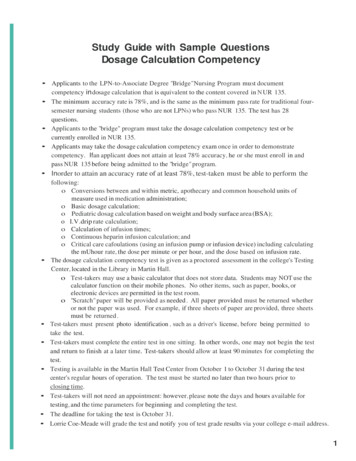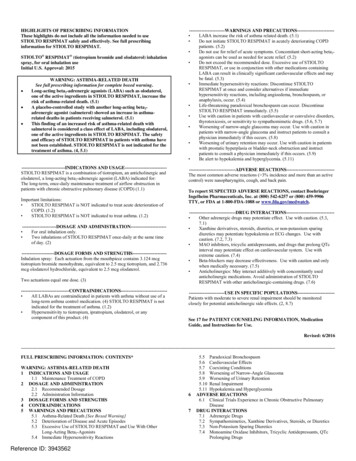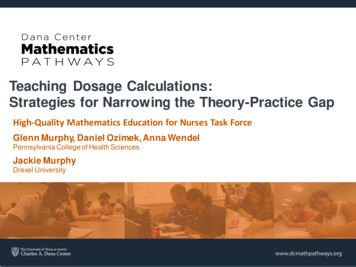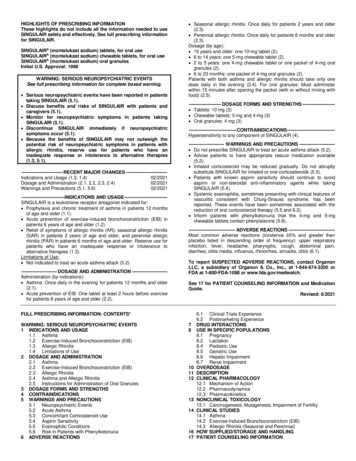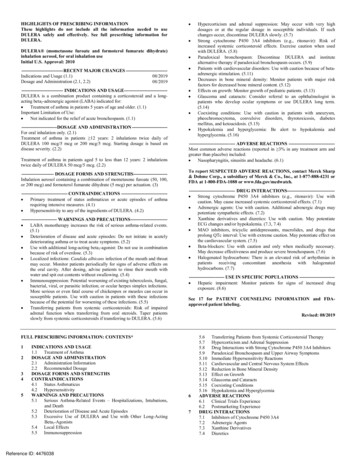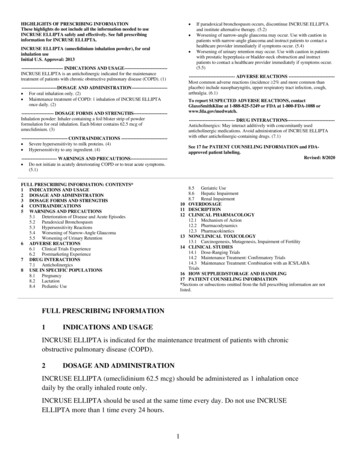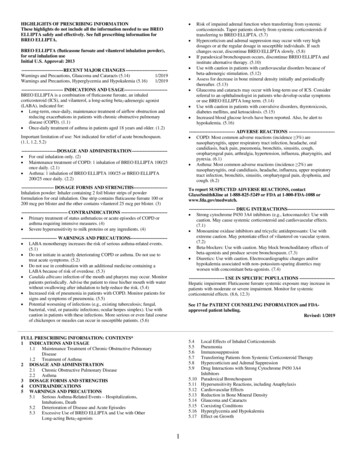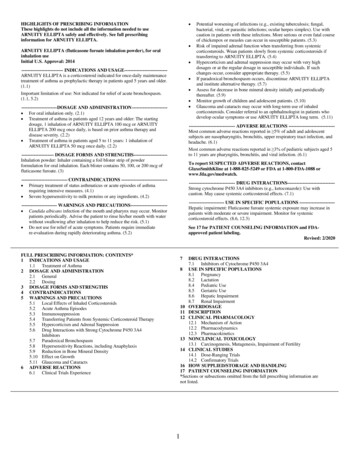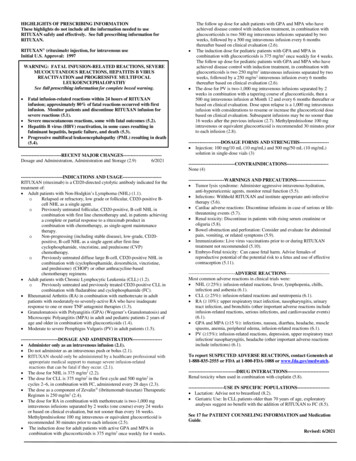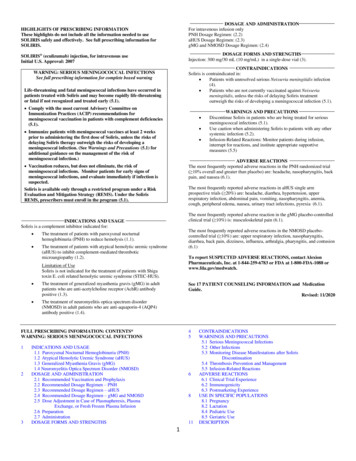
Transcription
DOSAGE AND ADMINISTRATIONFor intravenous infusion onlyPNH Dosage Regimen: (2.2)aHUS Dosage Regimen: (2.3)gMG and NMOSD Dosage Regimen: (2.4)DOSAGE FORMS AND STRENGTHSHIGHLIGHTS OF PRESCRIBING INFORMATIONThese highlights do not include all the information needed to useSOLIRIS safely and effectively. See full prescribing information forSOLIRIS.SOLIRIS (eculizumab) injection, for intravenous useInitial U.S. Approval: 2007Injection: 300 mg/30 mL (10 mg/mL) in a single-dose vial (3).CONTRAINDICATIONSWARNING: SERIOUS MENINGOCOCCAL INFECTIONSSee full prescribing information for complete boxed warningSoliris is contraindicated in: Patients with unresolved serious Neisseria meningitidis infection(4). Patients who are not currently vaccinated against Neisseriameningitidis, unless the risks of delaying Soliris treatmentoutweigh the risks of developing a meningococcal infection (5.1).Life-threatening and fatal meningococcal infections have occurred inpatients treated with Soliris and may become rapidly life-threateningor fatal if not recognized and treated early (5.1). Comply with the most current Advisory Committee onImmunization Practices (ACIP) recommendations formeningococcal vaccination in patients with complement deficiencies(5.1).WARNINGS AND PRECAUTIONS Immunize patients with meningococcal vaccines at least 2 weeksprior to administering the first dose of Soliris, unless the risks ofdelaying Soliris therapy outweigh the risks of developing ameningococcal infection. (See Warnings and Precautions (5.1) foradditional guidance on the management of the risk ofmeningococcal infection.) Discontinue Soliris in patients who are being treated for seriousmeningococcal infections (5.1).Use caution when administering Soliris to patients with any othersystemic infection (5.2).Infusion-Related Reactions: Monitor patients during infusion,interrupt for reactions, and institute appropriate supportivemeasures (5.5)ADVERSE REACTIONS Vaccination reduces, but does not eliminate, the risk ofmeningococcal infections. Monitor patients for early signs ofmeningococcal infections, and evaluate immediately if infection issuspected.The most frequently reported adverse reactions in the PNH randomized trial( 10% overall and greater than placebo) are: headache, nasopharyngitis, backpain, and nausea (6.1).Soliris is available only through a restricted program under a RiskEvaluation and Mitigation Strategy (REMS). Under the SolirisREMS, prescribers must enroll in the program (5.1).The most frequently reported adverse reactions in aHUS single armprospective trials ( 20%) are: headache, diarrhea, hypertension, upperrespiratory infection, abdominal pain, vomiting, nasopharyngitis, anemia,cough, peripheral edema, nausea, urinary tract infections, pyrexia (6.1).The most frequently reported adverse reaction in the gMG placebo-controlledclinical trial ( 10%) is: musculoskeletal pain (6.1).INDICATIONS AND USAGESoliris is a complement inhibitor indicated for: The treatment of patients with paroxysmal nocturnalhemoglobinuria (PNH) to reduce hemolysis (1.1). The treatment of patients with atypical hemolytic uremic syndrome(aHUS) to inhibit complement-mediated thromboticmicroangiopathy (1.2).The most frequently reported adverse reactions in the NMOSD placebocontrolled trial ( 10%) are: upper respiratory infection, nasopharyngitis,diarrhea, back pain, dizziness, influenza, arthralgia, pharyngitis, and contusion(6.1)To report SUSPECTED ADVERSE REACTIONS, contact AlexionPharmaceuticals, Inc. at 1-844-259-6783 or FDA at 1-800-FDA-1088 orwww.fda.gov/medwatch.Limitation of UseSoliris is not indicated for the treatment of patients with Shigatoxin E. coli related hemolytic uremic syndrome (STEC-HUS). The treatment of generalized myasthenia gravis (gMG) in adultpatients who are anti-acetylcholine receptor (AchR) antibodypositive (1.3). The treatment of neuromyelitis optica spectrum disorder(NMOSD) in adult patients who are anti-aquaporin-4 (AQP4)antibody positive (1.4).See 17 PATIENT COUNSELING INFORMATION and MedicationGuide.Revised: 11/2020FULL PRESCRIBING INFORMATION: CONTENTS*WARNING: SERIOUS MENINGOCOCCAL INFECTIONS12345INDICATIONS AND USAGE1.1 Paroxysmal Nocturnal Hemoglobinuria (PNH)1.2 Atypical Hemolytic Uremic Syndrome (aHUS)1.3 Generalized Myasthenia Gravis (gMG)1.4 Neuromyelitis Optica Spectrum Disorder (NMOSD)DOSAGE AND ADMINISTRATION2.1 Recommended Vaccination and Prophylaxis2.2 Recommended Dosage Regimen – PNH2.3 Recommended Dosage Regimen – aHUS2.4 Recommended Dosage Regimen – gMG and NMOSD2.5 Dose Adjustment in Case of Plasmapheresis, PlasmaExchange, or Fresh Frozen Plasma Infusion2.6 Preparation2.7 AdministrationDOSAGE FORMS AND STRENGTHS68111CONTRAINDICATIONSWARNINGS AND PRECAUTIONS5.1 Serious Meningococcal Infections5.2 Other Infections5.3 Monitoring Disease Manifestations after SolirisDiscontinuation5.4 Thrombosis Prevention and Management5.5 Infusion-Related ReactionsADVERSE REACTIONS6.1 Clinical Trial Experience6.2 Immunogenicity6.3 Postmarketing ExperienceUSE IN SPECIFIC POPULATIONS8.1 Pregnancy8.2 Lactation8.4 Pediatric Use8.5 Geriatric UseDESCRIPTION
121314CLINICAL PHARMACOLOGY12.1 Mechanism of Action12.2 Pharmacodynamics12.3 PharmacokineticsNONCLINICAL TOXICOLOGY13.1 Carcinogenesis, Mutagenesis, Impairment of FertilityCLINICAL STUDIES14.1 Paroxysmal Nocturnal Hemoglobinuria (PNH)14.2 Atypical Hemolytic Uremic Syndrome (aHUS)161714.3 Generalized Myasthenia Gravis (gMG)14.4 Neuromyelitis Optica Spectrum Disorder (NMOSD)HOW SUPPLIED/STORAGE AND HANDLINGPATIENT COUNSELING INFORMATION*Sections or subsections omitted from the full prescribing informationare not listed.2
FULL PRESCRIBING INFORMATIONWARNING: SERIOUS MENINGOCOCCAL INFECTIONSLife-threatening and fatal meningococcal infections have occurred in patientstreated with Soliris. Meningococcal infection may become rapidly life-threateningor fatal if not recognized and treated early [see Warnings and Precautions (5.1)]. Comply with the most current Advisory Committee on ImmunizationPractices (ACIP) recommendations for meningococcal vaccination in patientswith complement deficiencies. Immunize patients with meningococcal vaccines at least 2 weeks prior toadministering the first dose of Soliris, unless the risks of delaying Soliristherapy outweigh the risk of developing a meningococcal infection. [SeeWarnings and Precautions (5.1) for additional guidance on the management ofthe risk of meningococcal infection]. Vaccination reduces, but does not eliminate, the risk of meningococcalinfections. Monitor patients for early signs of meningococcal infections andevaluate immediately if infection is suspected.Soliris is available only through a restricted program under a Risk Evaluationand Mitigation Strategy (REMS). Under the Soliris REMS, prescribers mustenroll in the program [see Warnings and Precautions (5.1)]. Enrollment in theSoliris REMS program and additional information are available by telephone: 1888-SOLIRIS (1-888-765-4747) or at www.solirisrems.com.1INDICATIONS AND USAGE1.1Paroxysmal Nocturnal Hemoglobinuria (PNH)Soliris is indicated for the treatment of patients with paroxysmal nocturnalhemoglobinuria (PNH) to reduce hemolysis.1.2Atypical Hemolytic Uremic Syndrome (aHUS)Soliris is indicated for the treatment of patients with atypical hemolytic uremic syndrome(aHUS) to inhibit complement-mediated thrombotic microangiopathy.Limitation of UseSoliris is not indicated for the treatment of patients with Shiga toxin E. coli relatedhemolytic uremic syndrome (STEC-HUS).3
1.3Generalized Myasthenia Gravis (gMG)Soliris is indicated for the treatment of generalized myasthenia gravis (gMG) in adultpatients who are anti-acetylcholine receptor (AchR) antibody positive.1.4Neuromyelitis Optica Spectrum Disorder (NMOSD)Soliris is indicated for the treatment of neuromyelitis optica spectrum disorder (NMOSD)in adult patients who are anti-aquaporin-4 (AQP4) antibody positive.22.1DOSAGE AND ADMINISTRATIONRecommended Vaccination and ProphylaxisVaccinate patients according to current ACIP guidelines to reduce the risk of seriousinfection [see Warnings and Precautions (5.1 and 5.2)].Provide two weeks of antibacterial drug prophylaxis to patients if Soliris must be initiatedimmediately and vaccines are administered less than two weeks before starting Soliristherapy.Healthcare professionals who prescribe Soliris must enroll in the Soliris REMS [seeWarnings and Precautions (5.1)].Recommended Dosage Regimen – PNH2.2For patients 18 years of age and older, Soliris therapy consists of: 600 mg weekly for the first 4 weeks, followed by 900 mg for the fifth dose 1 week later, then 900 mg every 2 weeks thereafter.Administer Soliris at the recommended dosage regimen time points, or within two daysof these time points [see Warnings and Precautions (5.4)].Recommended Dosage Regimen – aHUS2.3For patients 18 years of age and older, Soliris therapy consists of: 900 mg weekly for the first 4 weeks, followed by 1200 mg for the fifth dose 1 week later, then 1200 mg every 2 weeks thereafter.For patients less than 18 years of age, administer Soliris based upon body weight,according to the following schedule (Table 1):4
Table 1:Dosing Recommendations in aHUS Patients Less Than 18 Years ofAgePatient Body WeightInductionMaintenance40 kg and over900 mg weekly x 4doses1200 mg at week 5;then 1200 mg every 2 weeks600 mg weekly x 2doses600 mg weekly x 2doses900 mg at week 3;then 900 mg every 2 weeks600 mg at week 3;then 600 mg every 2 weeks300 mg at week 2;then 300 mg every 2 weeks300 mg at week 2;then 300 mg every 3 weeks30 kg to less than 40 kg20 kg to less than 30 kg10 kg to less than 20 kg600 mg weekly x 1 dose5 kg to less than 10 kg300 mg weekly x 1 doseAdminister Soliris at the recommended dosage regimen time points, or within two daysof these time points.Recommended Dosage Regimen – gMG and NMOSD2.4For adult patients with generalized myasthenia gravis or neuromyelitis optica spectrumdisorder, Soliris therapy consists of: 900 mg weekly for the first 4 weeks, followed by 1200 mg for the fifth dose 1 week later, then 1200 mg every 2 weeks thereafter.Administer Soliris at the recommended dosage regimen time points, or within two daysof these time points.2.5Dose Adjustment in Case of Plasmapheresis, Plasma Exchange,or Fresh Frozen Plasma InfusionFor adult and pediatric patients with aHUS, and adult patients with gMG or NMOSD,supplemental dosing of Soliris is required in the setting of concomitant plasmapheresis orplasma exchange, or fresh frozen plasma infusion (PE/PI) (Table 2).Table 2:Supplemental Dose of Soliris after PE/PIType of PlasmaInterventionPlasmapheresis orplasma exchangeMost RecentSoliris Dose300 mgSupplemental SolirisDose with EachPlasma Intervention300 mg per eachplasmapheresis or5Timing ofSupplemental SolirisDoseWithin 60 minutesafter each
plasma exchangesession600 mg per eachplasmapheresis orplasma exchangesession 600 mgFresh frozen plasmainfusion2.6 300 mg300 mg per infusion offresh frozen plasmaplasmapheresis orplasma exchange60 minutes prior toeach infusion of freshfrozen plasmaPreparationDilute Soliris to a final admixture concentration of 5 mg/mL using the following steps: Withdraw the required amount of Soliris from the vial into a sterile syringe. Transfer the recommended dose to an infusion bag. Dilute Soliris to a final concentration of 5 mg/mL by adding the appropriateamount (equal volume of diluent to drug volume) of 0.9% Sodium ChlorideInjection, USP; 0.45% Sodium Chloride Injection, USP; 5% Dextrose inWater Injection, USP; or Ringer’s Injection, USP to the infusion bag.The final admixed Soliris 5 mg/mL infusion volume is 60 mL for 300 mg doses, 120 mLfor 600 mg doses, 180 mL for 900 mg doses or 240 mL for 1200 mg doses (Table 3).Table 3:Preparation and Reconstitution of SolirisSoliris Dose300 mg600 mg900 mg1200 mgDiluent Volume30 mL60 mL90 mL120 mLFinal Volume60 mL120 mL180 mL240 mLGently invert the infusion bag containing the diluted Soliris solution to ensure thoroughmixing of the product and diluent. Discard any unused portion left in a vial, as theproduct contains no preservatives.Prior to administration, the admixture should be allowed to adjust to room temperature[18 -25 C, 64 -77 F]. The admixture must not be heated in a microwave or with anyheat source other than ambient air temperature.Parenteral drug products should be inspected visually for particulate matter anddiscoloration prior to administration, whenever solution and container permit.2.7AdministrationOnly administer as an intravenous infusion.Do not administer as an intravenous push or bolus injection.Administer the Soliris admixture by intravenous infusion over 35 minutes in adults and 1to 4 hours in pediatric patients via gravity feed, a syringe-type pump, or an infusion6
pump. Admixed solutions of Soliris are stable for 24 h at 2 -8 C (36 -46 F) and at roomtemperature.If an adverse reaction occurs during the administration of Soliris, the infusion may beslowed or stopped at the discretion of the physician. If the infusion is slowed, the totalinfusion time should not exceed two hours in adults. Monitor the patient for at least onehour following completion of the infusion for signs or symptoms of an infusion-relatedreaction.3DOSAGE FORMS AND STRENGTHSInjection: 300 mg/30 mL (10 mg/mL) as a clear, colorless solution in a single-dose vial.4CONTRAINDICATIONSSoliris is contraindicated in: Patients with unresolved serious Neisseria meningitidis infection [seeWarnings and Precautions (5.1)]. Patients who are not currently vaccinated against Neisseria meningitidis,unless the risks of delaying Soliris treatment outweigh the risks of developinga meningococcal infection [see Warnings and Precautions (5.1)].7
5WARNINGS AND PRECAUTIONS5.1Serious Meningococcal InfectionsRisk and PreventionLife-threatening and fatal meningococcal infections have occurred in patients treated with Soliris.The use of Soliris increases a patient's susceptibility to serious meningococcal infections (septicemiaand/or meningitis). Soliris is associated with an approximate 2,000-fold increased risk ofmeningococcal disease in comparison to the general U.S. population annual rate (0.14 per 100,000population in 2015).Vaccinate for meningococcal disease according to the most current Advisory Committee onImmunization Practices (ACIP) recommendations for patients with complement deficiencies.Revaccinate patients in accordance with ACIP recommendations, considering the duration of Soliristherapy.Immunize patients without a history of meningococcal vaccination at least 2 weeks prior to receivingthe first dose of Soliris. If urgent Soliris therapy is indicated in an unvaccinated patient, administermeningococcal vaccine(s) as soon as possible and provide patients with two weeks of antibacterialdrug prophylaxis.In prospective clinical studies, 75/100 patients with aHUS were treated with Soliris less than 2 weeksafter meningococcal vaccination and 64 of these 75 patients received antibiotics for prophylaxis ofmeningococcal infection until at least 2 weeks after meningococcal vaccination. The benefits andrisks of antibiotic prophylaxis for prevention of meningococcal infections in patients receiving Solirishave not been established.Vaccination reduces, but does not eliminate, the risk of meningococcal infections. In clinical studies,2 out of 196 PNH patients developed serious meningococcal infections while receiving treatmentwith Soliris; both had been vaccinated [see Adverse Reactions (6.1)]. In clinical studies among nonPNH patients, meningococcal meningitis occurred in one unvaccinated patient. In addition, 3 out of130 previously vaccinated patients with aHUS developed meningococcal infections while receivingtreatment with Soliris [see Adverse Reactions (6.1)].Closely monitor patients for early signs and symptoms of meningococcal infection and evaluatepatients immediately if an infection is suspected. Meningococcal infection may become rapidly lifethreatening or fatal if not recognized and treated early. Discontinue Soliris in patients who areundergoing treatment for serious meningococcal infections.REMSBecause of the risk of meningococcal infections, Soliris is available only through a restricted programunder a Risk Evaluation and Mitigation Strategy (REMS). Under the Soliris REMS, prescribers mustenroll in the program.Prescribers must counsel patients about the risk of meningococcal infection, provide the patients withthe REMS educational materials, and ensure patients are vaccinated with meningococcal vaccine(s).Enrollment in the Soliris REMS program and additional information are available by telephone: 1888-SOLIRIS (1-888-765-4747) or at www.solirisrems.com.8
5.2Other InfectionsSerious infections with Neisseria species (other than N. meningitidis), including disseminatedgonococcal infections, have been reported.Soliris blocks terminal complement activation; therefore patients may have increased susceptibility toinfections, especially with encapsulated bacteria. Additionally, Aspergillus infections have occurredin immunocompromised and neutropenic patients. Children treated with Soliris may be at increasedrisk of developing serious infections due to Streptococcus pneumoniae and Haemophilus influenzaetype b (Hib). Administer vaccinations for the prevention of Streptococcus pneumoniae andHaemophilus influenzae type b (Hib) infections according to ACIP guidelines. Use caution whenadministering Soliris to patients with any systemic infection [see Warnings and Precautions (5.1)].5.3Monitoring Disease Manifestations after Soliris DiscontinuationTreatment Discontinuation for PNHMonitor patients after discontinuing Soliris for at least 8 weeks to detect hemolysis.Treatment Discontinuation for aHUSAfter discontinuing Soliris, monitor patients with aHUS for signs and symptoms of thromboticmicroangiopathy (TMA) complications for at least 12 weeks. In aHUS clinical trials, 18 patients (5 inthe prospective studies) discontinued Soliris treatment. TMA complications occurred following amissed dose in 5 patients, and Soliris was reinitiated in 4 of these 5 patients.Clinical signs and symptoms of TMA include changes in mental status, seizures, angina, dyspnea, orthrombosis. In addition, the following changes in laboratory parameters may identify a TMAcomplication: occurrence of two, or repeated measurement of any one of the following: a decrease inplatelet count by 25% or more compared to baseline or the peak platelet count during Soliristreatment; an increase in serum creatinine by 25% or more compared to baseline or nadir duringSoliris treatment; or, an increase in serum LDH by 25% or more over baseline or nadir during Soliristreatment.If TMA complications occur after Soliris discontinuation, consider reinstitution of Soliris treatment,plasma therapy [plasmapheresis, plasma exchange, or fresh frozen plasma infusion (PE/PI)], orappropriate organ-specific supportive measures.5.4Thrombosis Prevention and ManagementThe effect of withdrawal of anticoagulant therapy during Soliris treatment has not been established.Therefore, treatment with Soliris should not alter anticoagulant management.5.5Infusion-Related ReactionsAdministration of Soliris may result in infusion-related reactions, including anaphylaxis or otherhypersensitivity reactions. In clinical trials, no patients experienced an infusion-related reactionwhich required discontinuation of Soliris. Interrupt Soliris infusion and institute appropriatesupportive measures if signs of cardiovascular instability or respiratory compromise occur.9
6ADVERSE REACTIONSThe following serious adverse reactions are discussed in greater detail in other sections of thelabeling: Serious Meningococcal Infections [see Warnings and Precautions (5.1)] Other Infections [see Warnings and Precautions (5.2)] Monitoring Disease Manifestations after Soliris Discontinuation [see Warnings andPrecautions (5.3)] Thrombosis Prevention and Management [see Warnings and Precautions (5.4)] Infusion-Related Reactions [see Warnings and Precautions (5.5)]6.1Clinical Trial ExperienceBecause clinical trials are conducted under widely varying conditions, adverse reaction rates observedin the clinical trials of a drug cannot be directly compared to rates in the clinical trials of another drugand may not reflect the rates observed in practice.Meningococcal infections are the most important adverse reactions experienced by patients receivingSoliris. In PNH clinical studies, two patients experienced meningococcal sepsis. Both patients hadpreviously received a meningococcal vaccine. In clinical studies among patients without PNH,meningococcal meningitis occurred in one unvaccinated patient. Meningococcal sepsis occurred inone previously vaccinated patient enrolled in the retrospective aHUS study during the post-studyfollow-up period [see Warnings and Precautions (5.1)].PNHThe data described below reflect exposure to Soliris in 196 adult patients with PNH, age 18-85, ofwhom 55% were female. All had signs or symptoms of intravascular hemolysis. Soliris was studied ina placebo-controlled clinical study (PNH Study 1, in which 43 patients received Soliris and 44,placebo); a single arm clinical study (PNH Study 2); and a long term extension study (E05-001). 182patients were exposed for greater than one year. All patients received the recommended Soliris doseregimen.Table 4 summarizes the adverse reactions that occurred at a numerically higher rate in the Solirisgroup than the placebo group and at a rate of 5% or more among patients treated with Soliris.Table 4:Adverse Reactions Reported in 5% or More of Soliris Treated Patients with PNHand Greater than Placebo in the Controlled Clinical StudyReactionSoliris(N 43)N (%)19 (44)10 (23)8 (19)7 (16)5 (12)5 (12)3 (7)HeadacheNasopharyngitisBack painNauseaFatigueCoughHerpes simplex infections10Placebo(N 44)N (%)12 (27)8 (18)4 (9)5 (11)1 (2)4 (9)0
SinusitisRespiratory tract infectionConstipationMyalgiaPain in extremityInfluenza-like illness3 (7)3 (7)3 (7)3 (7)3 (7)2 (5)01 (2)2 (5)1 (2)1 (2)1 (2)In the placebo-controlled clinical study, serious adverse reactions occurred among 4 (9%) patientsreceiving Soliris and 9 (21%) patients receiving placebo. The serious reactions included infectionsand progression of PNH. No deaths occurred in the study and no patients receiving Solirisexperienced a thrombotic event; one thrombotic event occurred in a patient receiving placebo.Among 193 patients with PNH treated with Soliris in the single arm, clinical study or the follow-upstudy, the adverse reactions were similar to those reported in the placebo-controlled clinical study.Serious adverse reactions occurred among 16% of the patients in these studies. The most commonserious adverse reactions were: viral infection (2%), headache (2%), anemia (2%), and pyrexia (2%).aHUSThe safety of Soliris therapy in patients with aHUS was evaluated in four prospective, single-armstudies, three in adult and adolescent patients (Studies C08-002A/B, C08-003A/B, and C10-004), onein pediatric and adolescent patients (Study C10-003), and one retrospective study (Study C09-001r).The data described below were derived from 78 adult and adolescent patients with aHUS in StudiesC08-002A/B, C08-003A/B and C10-004. All patients received the recommended dosage of Soliris.Median exposure was 67 weeks (range: 2-145 weeks). Table 5 summarizes all adverse eventsreported in at least 10% of patients in Studies C08-002A/B, C08-003A/B and C10-004 combined.Table 5:Per Patient Incidence of Adverse Events in 10% or More Adult and AdolescentPatients Enrolled in Studies C08-002A/B, C08-003A/B and C10-004 Separatelyand in TotalVascular DisordersHypertensionaHypotensionInfections and isUpper respiratory tract infectionUrinary tract infectionGastrointestinal DisordersDiarrheaVomitingNauseaC08-002A/B(N 17)C08-003A/B(N 20)Number (%) of PatientsC10-004(N 41)Total(N 78)10 (59)2 (12)9 (45)4 (20)7 (17)7 (17)26 (33)13 (17)3 (18)3 (18)3 (18)5 (29)6 (35)2 (10)11 (55)4 (20)8 (40)3 (15)4 (10)7 (17)2 (5)2 (5)8 (20)9 (12)21 (27)9 (12)15 (19)17 (22)8 (47)8 (47)5 (29)8 (40)9 (45)8 (40)12 (32)6 (15)5 (12)29 (37)23 (30)18 (23)11
Abdominal painNervous System DisordersHeadacheBlood and Lymphatic SystemDisordersAnemiaLeukopeniaPsychiatric DisordersInsomniaRenal and Urinary DisordersRenal ImpairmentProteinuriaRespiratory, Thoracic andMediastinal DisordersCoughGeneral Disorders andAdministration Site ConditionsFatiguePeripheral edemaPyrexiaAstheniaEye DisorderMetabolism and NutritionDisordersHypokalemiaNeoplasms benign, malignant,and unspecified (including cystsand polyps)Skin and Subcutaneous TissueDisordersRashPruritusMusculoskeletal and ConnectiveTissue DisordersArthralgiaBack paina.C08-002A/B(N 17)3 (18)C08-003A/B(N 20)6 (30)Number (%) of PatientsC10-004(N 41)6 (15)Total(N 78)15 (19)7 (41)10 (50)15 (37)32 (41)6 (35)4 (24)7 (35)3 (15)7 (17)5 (12)20 (26)12 (15)4 (24)2 (10)5 (12)11 (14)5 (29)2 (12)3 (15)1 (5)6 (15)5 (12)14 (18)8 (10)4 (24)6 (30)8 (20)18 (23)3 (18)5 (29)4 (24)3 (18)5 (29)4 (20)4 (20)5 (25)4 (20)2 (10)3 (7)9 (22)7 (17)6 (15)8 (20)10 (13)18 (23)16 (21)13 (17)15 (19)3 (18)2 (10)4 (10)9 (12)1 (6)6 (30)1 (20)8 (10)2 (12)1 (6)3 (15)3 (15)6 (15)4 (10)11 (14)8 (10)1 (6)3 (18)2 (10)3 (15)7 (17)2 (5)10 (13)8 (10)includes the preferred terms hypertension, accelerated hypertension, and malignant hypertension.In Studies C08-002A/B, C08-003A/B and C10-004 combined, 60% (47/78) of patients experienced aserious adverse event (SAE). The most commonly reported SAEs were infections (24%),hypertension (5%), chronic renal failure (5%), and renal impairment (5%). Five patients discontinued12
Soliris due to adverse events; three due to worsening renal function, one due to new diagnosis ofSystemic Lupus Erythematosus, and one due to meningococcal meningitis.Study C10-003 included 22 pediatric and adolescent patients, of which 18 patients were less than 12years of age. All patients received the recommended dosage of Soliris. Median exposure was 44weeks (range: 1 dose-87 weeks).Table 6 summarizes all adverse events reported in at least 10% of patients enrolled in Study C10-003.Table 6:Per Patient Incidence of Adverse Reactions in 10% or More Patients Enrolled inStudy C10-003Eye DisordersGastrointestinal DisordersAbdominal painDiarrheaVomitingDyspepsiaGeneral Disorders and AdministrationSite ConditionsPyrexiaInfections and InfestationsUpper respiratory tract infectionNasopharyngitisRhinitisUrinary Tract infectionCatheter site infectionMusculoskeletal and Connective TissueDisordersMuscle spasmsNervous System DisordersHeadacheRenal and Urinary DisordersRespiratory, Thoracic and MediastinalDisordersCoughOropharyngeal painSkin and Subcutaneous TissueDisordersRashVascular DisordersHypertension1 month to 12 yrs(N 18)3 (17)Total(N 22)3 (14)6 (33)5 (28)4 (22)07 (32)7 (32)6 (27)3 (14)9 (50)11 (50)5 (28)3 (17)4 (22)3 (17)3 (17)7 (32)6 (27)4 (18)4 (18)3 (14)2 (11)3 (14)3 (17)3 (17)4 (18)4 (18)7 (39)1 (6)8 (36)3 (14)4 (22)4 (18)4 (22)4 (18)In Study C10-003, 59% (13/22) of patients experienced a serious adverse event (SAE). The mostcommonly reported SAEs were hypertension (9%), viral gastroenteritis (9%), pyrexia (9%), andupper respiratory infection (9%). One patient discontinued Soliris due to an adverse event (severeagitation).13
Analysis of retrospectively collected adverse event data from pediatric and adult patients enrolled inStudy C09-001r (N 30) revealed a safety profile that was similar to that which was observed in thetwo prospective studies. Study C09-001r included 19 pediatric patients less than 18 years of age.Overall, the safety of Soliris in pediatric patients with aHUS enrolled in Study C09-001r appearedsimilar to that observed in adult patients. The most common ( 15%) adverse events occurring inpediatric patients are presented in Table 7.Table 7:Adverse Reactions Occurring in at Least 15% of PatientsLess than 18 Years of Age Enrolled in Study C09-001rNumber (%) of Patients2 to 12 yrs12 to 18 yrs(N 10)(N 4) 2 yrs(N 5)General Disorders andAdministration Site ConditionsPyrexiaGastrointestinal DisordersDiarrheaVomitingInfections and InfestationsUpper respiratory tract infectionaRespiratory, Thoracic andMediastinal DisordersCoughNasal congestionCardiac DisordersTachycardiaa.Total(N 19)4 (80)4 (40)1 (25)9 (47)1 (20)2 (40)4 (40)1 (10)1 (25)1 (25)6 (32)4 (21)2 (40)3 (30)1 (25)6 (32)3 (60)2 (40)2 (20)2 (20)0 (0)0 (0)5 (26)4 (21)2 (40)2 (20)0 (0)4 (21)includes the preferred terms upper respiratory tract infection and nasopharyngitis.Generalized Myasthenia Gravis (gMG)In a 26-week placebo-controlled trial evaluating the effect of Soliris for the treatment of gMG (gMGStudy 1), 62 patients received Soliris at the recommended dosage regimen and 63 patients receivedplacebo [see Clinical Studies (14.3)]. Patients were 19 to 79 years of age, and 66% were female.Table 8 displays the most common adverse reactions from gMG Study 1 that occurred in 5% ofSoliris-treated patients and at a greater frequency than on placebo.Table 8: Adverse Reactions Reported in 5% or More of Soliris-Treated Patients in gMGStudy 1 and at a Greater Frequency than in Placebo-Treated PatientsSoliris(N 62)N (%)Gastrointestinal DisordersAbdominal painGeneral Disorders andAdministration Site Conditions5 (8)Placebo(N 63)N (%)3 (5)14
Peripheral edemaPyrexiaInfections and InfestationsHerpes simplex virus infectionsInjury, Poisoning, and ProceduralComplicationsContusion5 (8)4 (7)3 (5)2 (3)5 (8)1 (2)5 (8)2 (3)Musculoskeletal and ConnectiveTissue DisordersMusculoskeletal pain9 (15)5 (8)The most common adverse reactions ( 10%) that occurred in Soliris-treated patients in the long-termextension to gMG Study 1, Study ECU-MG-302, and that are not included in Table 8 were headache(26%), nasopharyngitis (24%), diarrhea (15%), arthralgia (12%), upper respiratory tract infection(11%), and na
Guide. Revised: 11/2020 FULL PRESCRIBING INFORMATION: CONTENTS* WARNING: SERIOUS MENINGOCOCCAL INFECTIONS 1 INDICATIONS AND USAGE 1.1 Paroxysmal Nocturnal Hemoglobinuria (PNH) 1.2 Atypical Hemolytic Uremic Syndrome (aHUS) 1.3 Generalized Myasthenia Gravis (

